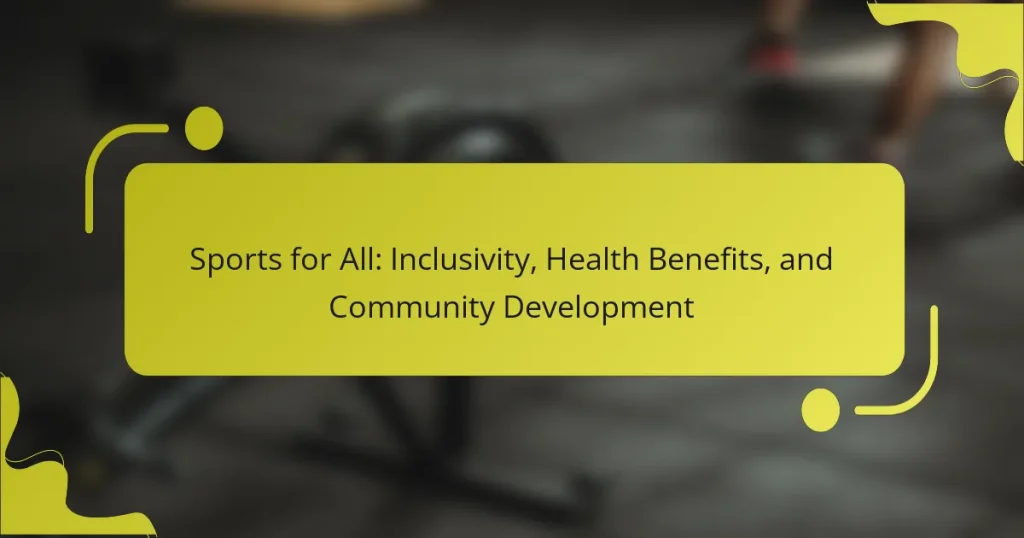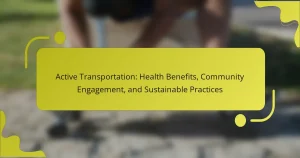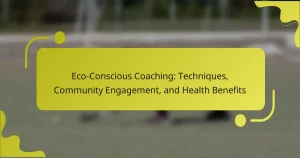Inclusive sports programs enhance community engagement and promote health benefits for all participants. They improve physical fitness, mental well-being, and social connections. Addressing challenges like funding and accessibility is crucial for fostering a supportive environment. Community development initiatives play a vital role in sustaining inclusivity and ensuring everyone can participate in physical activities.
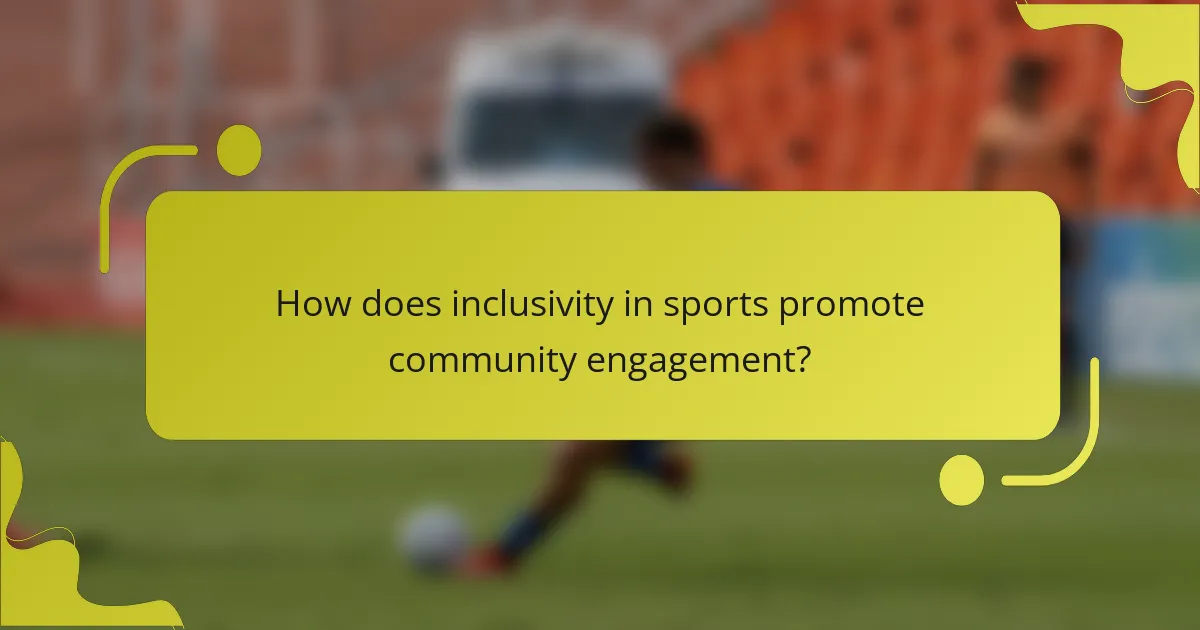
How does inclusivity in sports promote community engagement?
Inclusivity in sports fosters community engagement by creating shared experiences and breaking down barriers. It encourages participation from diverse groups, enhancing social cohesion. Events that promote inclusivity often lead to increased volunteerism, community pride, and collaboration among organizations. As a result, individuals feel a stronger connection to their local community, contributing to overall community development.
What are the key benefits of inclusive sports programs?
Inclusive sports programs offer numerous benefits, including improved physical health, enhanced mental well-being, and strengthened community ties. These programs promote social integration, allowing individuals from diverse backgrounds to participate together. As a result, participants often experience increased self-esteem and reduced feelings of isolation. Additionally, inclusive sports foster teamwork and cooperation, essential skills that benefit both personal and professional relationships. Statistics show that communities with inclusive sports programs report higher levels of social cohesion, highlighting their role in community development.
Which organizations are leading the way in sports inclusivity?
Organizations leading the way in sports inclusivity include the Special Olympics, Paralympics, and the Women’s Sports Foundation. These entities promote equitable participation and community development through various initiatives.
The Special Olympics focuses on athletes with intellectual disabilities, providing opportunities for competition and social inclusion. The Paralympics empowers athletes with physical disabilities, showcasing their talents on an international stage. The Women’s Sports Foundation advocates for gender equality in sports, striving to eliminate barriers for female athletes.
These organizations exemplify the commitment to inclusivity, enhancing health benefits and fostering community connections through sports. Their initiatives inspire positive change, encouraging diverse participation at all levels.
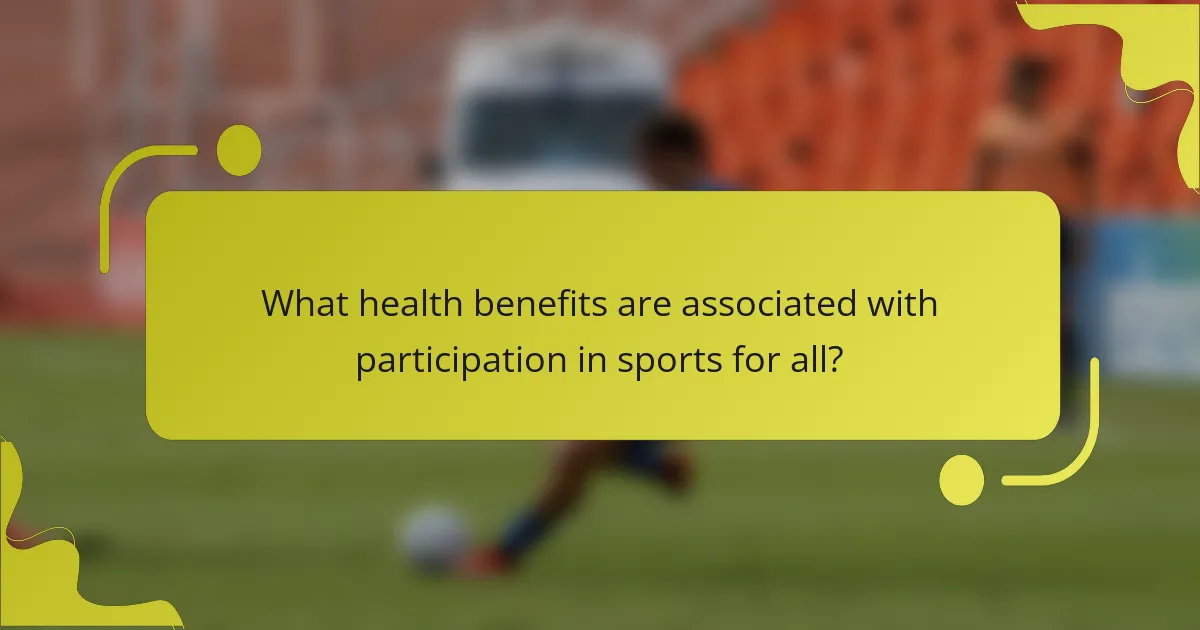
What health benefits are associated with participation in sports for all?
Participation in sports for all offers numerous health benefits, including improved physical fitness, mental well-being, and social connections. Engaging in physical activities enhances cardiovascular health, strengthens muscles, and boosts endurance. Regular participation can reduce the risk of chronic diseases such as obesity and diabetes.
Additionally, sports foster mental health by alleviating stress and anxiety. The social aspect of team sports encourages community development and inclusivity, promoting stronger interpersonal relationships. Studies indicate that inclusive sports programs can enhance self-esteem and provide a sense of belonging, particularly for marginalized groups.
Overall, the multifaceted health benefits of sports for all contribute to healthier individuals and cohesive communities.
How does regular physical activity improve mental health?
Regular physical activity significantly enhances mental health by reducing symptoms of anxiety and depression. Engaging in sports fosters social connections, which contribute to emotional well-being. It also promotes the release of endorphins, improving mood and overall mental resilience. Studies indicate that individuals who participate in inclusive sports experience heightened self-esteem and a sense of belonging, further supporting mental health.
What specific health outcomes can be achieved through inclusive sports?
Inclusive sports can lead to improved physical health, mental well-being, and social connections. Participation in these activities enhances cardiovascular fitness, reduces anxiety, and fosters community integration. Studies show that individuals involved in inclusive sports report higher self-esteem and lower levels of depression. Additionally, inclusive sports promote teamwork and communication skills, creating a supportive environment for all participants.
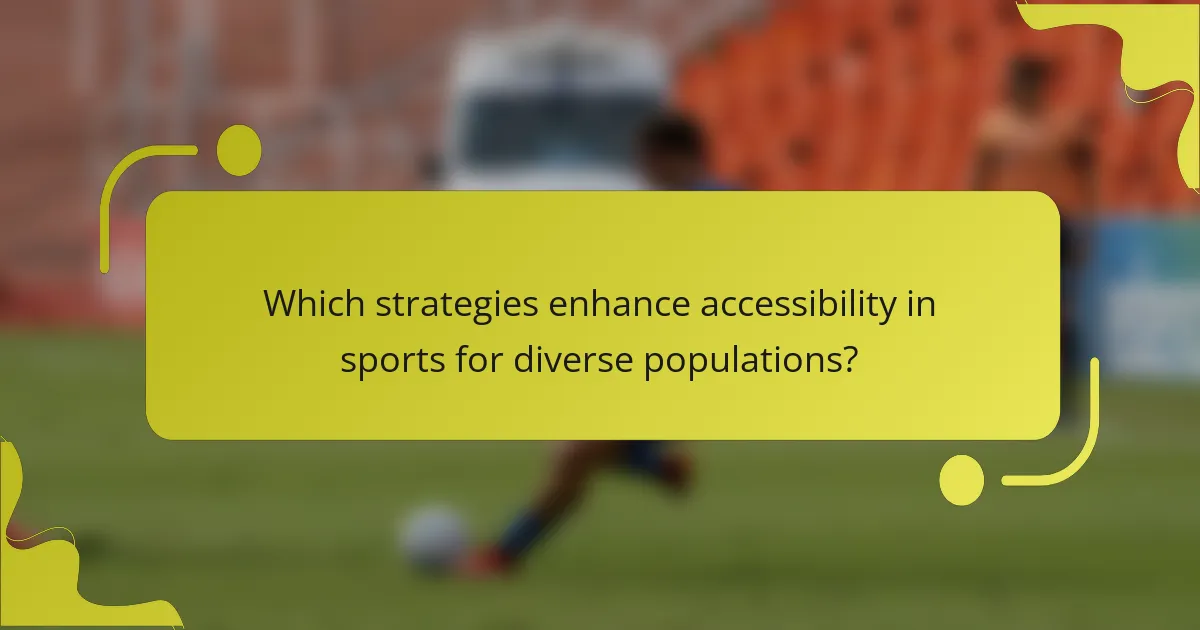
Which strategies enhance accessibility in sports for diverse populations?
Implementing strategies such as adaptive programs, community partnerships, and inclusive facilities enhances accessibility in sports for diverse populations. Adaptive programs cater to varying abilities, ensuring participation. Community partnerships foster outreach and engagement, promoting awareness. Inclusive facilities remove physical barriers, enabling access for everyone. These approaches collectively create a welcoming environment that supports inclusivity, health benefits, and community development.
What role do adaptive sports play in promoting inclusivity?
Adaptive sports play a crucial role in promoting inclusivity by providing opportunities for individuals with disabilities to participate in physical activities. These sports foster a sense of belonging and community, breaking down barriers and challenging stereotypes. Participation in adaptive sports enhances physical health, improves mental well-being, and encourages social interaction. Programs that support adaptive sports often lead to increased awareness and acceptance within society, contributing to overall community development.
How can community centers facilitate inclusive sports initiatives?
Community centers can facilitate inclusive sports initiatives by providing accessible facilities, offering diverse programs, and fostering a welcoming environment. These centers often adapt activities to accommodate various abilities, promoting participation among all community members. They can also collaborate with local organizations to create outreach programs that target underrepresented groups, enhancing community engagement. Research shows that inclusive sports initiatives improve physical health and social cohesion, contributing to overall community development.
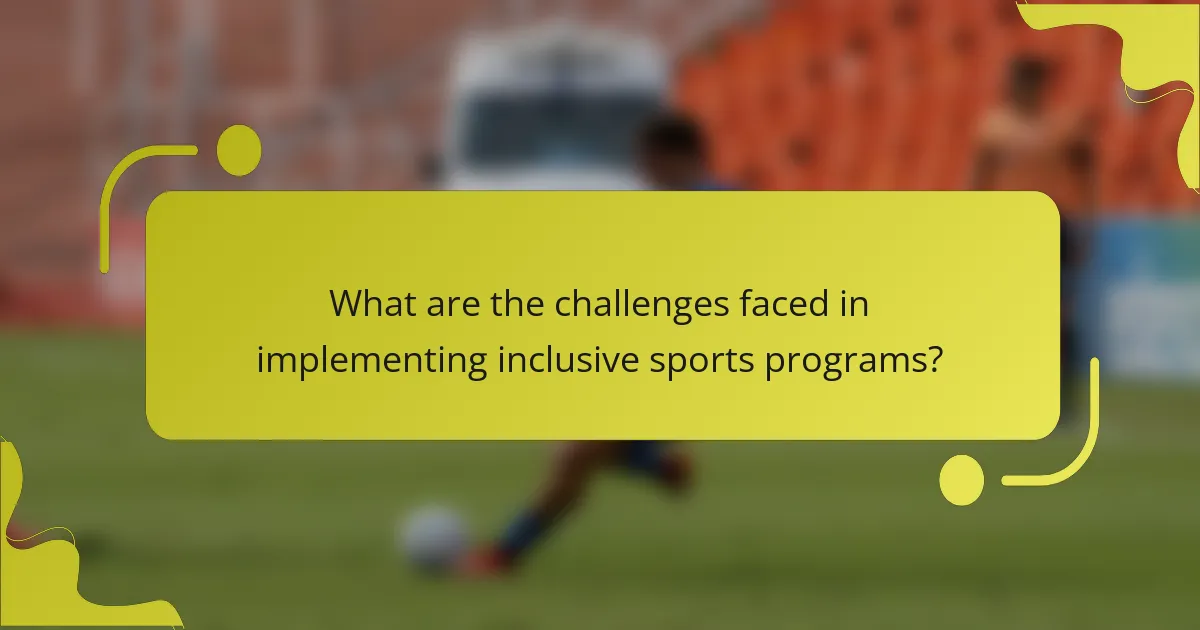
What are the challenges faced in implementing inclusive sports programs?
Implementing inclusive sports programs faces several challenges. Key issues include funding limitations, lack of accessible facilities, insufficient training for coaches, and societal attitudes towards disabilities.
Funding limitations hinder the development of inclusive programs, as resources are often allocated to traditional sports. Lack of accessible facilities can prevent participation, especially for individuals with mobility challenges. Insufficient training for coaches means they may not be equipped to support diverse needs effectively. Societal attitudes can create stigma, discouraging individuals from participating in sports.
Addressing these challenges requires a multifaceted approach, including community engagement and advocacy for policy changes.
How do funding and resources impact the success of inclusivity in sports?
Funding and resources significantly enhance the success of inclusivity in sports. Adequate financial support allows organizations to create accessible programs, facilities, and equipment. For instance, investing in adaptive sports gear opens opportunities for athletes with disabilities. Community engagement increases with well-resourced initiatives, fostering participation among diverse populations. Moreover, funding can facilitate training for coaches, ensuring they are equipped to support inclusivity effectively. Ultimately, the availability of resources directly correlates with improved health benefits and community development through sports.
Which barriers exist for individuals with disabilities in sports participation?
Individuals with disabilities face various barriers in sports participation, including accessibility, social stigma, and lack of resources. Accessibility issues often stem from inadequate facilities and equipment designed for inclusive use. Social stigma can discourage participation due to negative perceptions or lack of awareness among the community. Additionally, limited funding and resources hinder the availability of adaptive sports programs, reducing opportunities for individuals with disabilities to engage in physical activities. Addressing these barriers is crucial for promoting inclusivity and enhancing overall health benefits within the community.
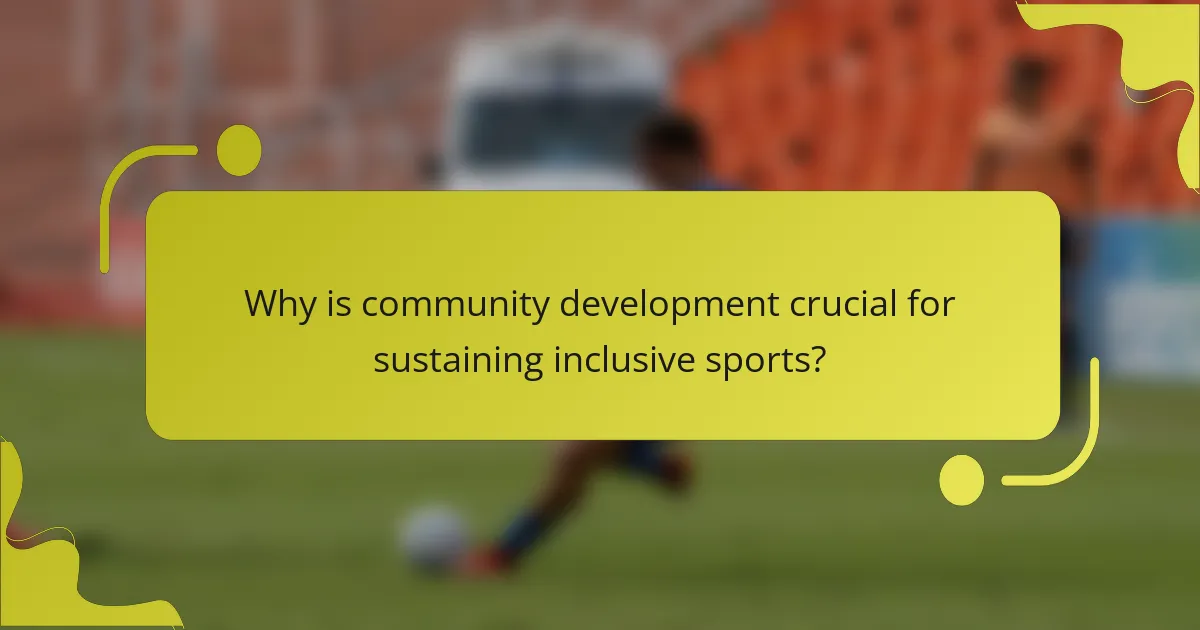
Why is community development crucial for sustaining inclusive sports?
Community development is essential for sustaining inclusive sports as it fosters participation and engagement. By creating supportive environments, communities can enhance access to sports for marginalized groups. This inclusivity leads to improved health outcomes and social cohesion. Furthermore, community development initiatives can provide resources, training, and facilities, ensuring that everyone has the opportunity to engage in physical activities. Ultimately, these efforts contribute to a healthier society and promote a culture of inclusivity in sports.
How can local governments support inclusive sports initiatives?
Local governments can support inclusive sports initiatives by providing funding, facilities, and community programs. They can create partnerships with local organizations to promote access to sports for all individuals, regardless of ability.
Investing in accessible venues ensures that everyone can participate in physical activities. This includes features like wheelchair ramps and adaptive equipment. Additionally, local governments can host events that celebrate diversity in sports, fostering a sense of community and belonging.
Training programs for coaches can enhance their ability to support athletes with disabilities. By prioritizing inclusivity, local governments contribute to the overall health and well-being of their communities.
What partnerships are effective for fostering community development through sports?
Effective partnerships for fostering community development through sports include collaborations between local governments, non-profit organizations, schools, and sports clubs. These partnerships leverage resources and expertise to enhance inclusivity and health benefits. For example, joint initiatives can provide access to sports facilities, coaching, and programs that target underserved populations. Additionally, partnerships with health organizations can promote active lifestyles and wellness through sports. Engaging local businesses can also support funding and resources, creating a sustainable model for community development.
What best practices can organizations adopt to ensure sustainability in inclusive sports?
Organizations can adopt several best practices to ensure sustainability in inclusive sports. First, they should prioritize community engagement to understand local needs and preferences. This fosters a sense of ownership and belonging among participants. Second, implementing adaptive programs and equipment ensures that all individuals can participate regardless of ability. Third, training staff and volunteers in inclusivity promotes a supportive environment. Additionally, establishing partnerships with local organizations enhances resources and outreach. Finally, measuring and reporting on the impact of inclusive initiatives helps refine strategies and sustain funding.
